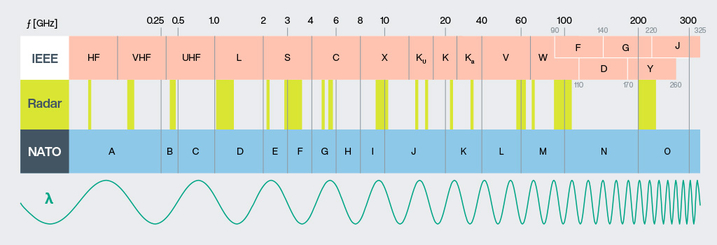Radar Frequency Bands

Radar devices operate in different frequency and wave ranges, which have different physical properties and each cover specific areas of application.
In the frequency range of several hundred megahertz (MHz), radar systems achieve long detection ranges and good penetration of obstacles. Radars for air surveillance and air defense, for example, operate in the VHF band (30 to 300 MHz). Modern air surveillance radars with a long detection range even operate in the frequency range of up to two gigahertz (GHz). The C-band (4 to 8 GHz) is used for weather radar and monitoring the sea surface. Radio waves in the X-band (8 to 12 GHz) offer high resolution and can penetrate thin walls. They are therefore suitable for precision applications and simple industrial applications.
As the transmission frequency increases, the detection range decreases due to attenuation in the atmosphere, while a higher range resolution becomes possible. In the K-band (18 to 27 GHz), for example, the airfield surveillance radar is operated, which can already detect the contours of aircraft and vehicles. Radars in the V-band (60 GHz) and above only achieve detection ranges of a few tens of meters, but the resolution is getting better and better. Like radars in the W-band, typical MIMO (multiple input multiple output) radars are imaging radars, i.e., 3-D radar systems with several emitting and receiving antennas. They are therefore used for more complex tasks such as environmental monitoring and object detection. Radars in the W-band (75 to 77 GHz) are frequently used in the automotive industry, for example as parking aids, brake assistants, and for automatic accident avoidance. There is also a frequency range around 80 GHz in the W-band, which is used for more complex and high-resolution tasks in level measurement in closed containers or tanks. The N-band (122 GHz), on the other hand, is preferred in measurement technology: radar modules in this frequency range can penetrate dry, non-conductive materials well and are applied, for example, as body scanners or for scanning packaged objects.









 +49 621 776-0
+49 621 776-0